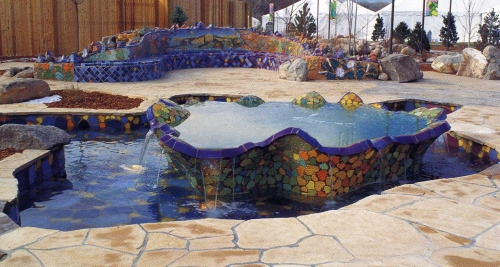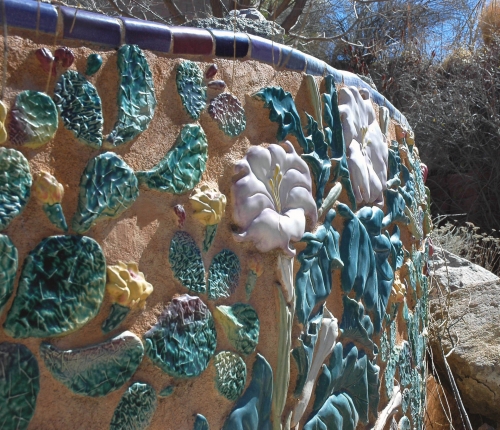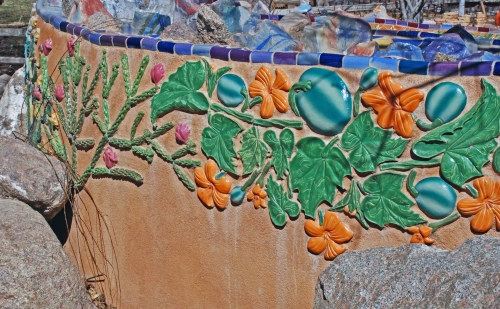Albuquerque, N.M. — On Wednesday, February 15, the Albuquerque Arts Board held its regularly scheduled meeting, which included a discussion of the fate of the Rosalie Doolittle Fountain designed, crafted and installed by New Mexico ceramic artist Shel Neymark at the Albuqeurque Botanic Garden in 1996.
The hybrid meeting included members of the community and the Mosaic New Mexico artist collective present in person, as well as over 20 interested local citizens or members of the tile arts community joining via zoom.
The fountain was the first order of business. Originally, it had been decided that a vote on decommissioning the fountain would be taken at this meeting. However, the board tabled that vote for further examination and discussion of the matter.

Prior to the meeting, community members, tile makers, craft persons, tile restoration advocates from across the country as well as members of Mosaic New Mexico artist collective signed a letter calling for restoration or preservation of the fountain and bench. Mosaic New Mexico member Cirrelda Snider-Bryan was present and read a portion of the letter during opening remarks. Over 152 community people signed the letter, in support of restoration or rebuild.
Several people gave testimony in person at the meeting, and many commented via Zoom, including artist Shel Neymark, who joined via Zoom due to treacherous weather conditions.
Supportive comments ranged from the cultural importance of the fountain, representation of the geography and plants of the area, inspiration for new generations of mosaic artists, its role in improving health, safety and self esteem amongst children and, and honoring author and consummate Albuquerque gardener Rosalie Doolittle.
Many comparisons were drawn between this work and Gaudi’s work in Barcelona and Parc Guell, including suggestions to consult with experts in Spain who have maintained Gaudi’s work over the years – in addition to local tile and restoration experts.
Neymark took issue with the actions of past boards that led to the deterioration of the fountain, but not the current board. Public Art Urban Enhancement Division Manager Sherri Brueggemann, MPA, said public art is “designed to be collaborative partnership between artist and Bio Park. There was a falling out, and resources were taken away from artist. We don’t do that anymore. It’s evident that the expertise and resources that were not made available to him contributed to the situation we find ourselves in.”




Neymark also pointed out that over the years the park has more than doubled in size. A Japanese garden, butterfly pavilion and bug house have all been built, but he was struggling to understand why there were no funds to clean minerals off the fountain every other month. He called out the city’s responsibility to the 22 donors who are named on a cement block that is part of the installation who gave funds to this project and expected the board to be “good stewards.”
The board discussed the particulars of the decommissioning process which Brueggemann said was not taken lightly. Decommissioning can result in relocation, sale or trade, the opportunity for the artist to buy back the work, auction or disposal in an “appropriate or practical way.”
Due to the deterioration of the tiles, some of which have separated from the base, there was discussion about completely rebuilding the project. Neymark himself admitted that the state of disrepair the sculpture had fallen into would necessitate reconstruction. He is still in possession of all the original molds and would be would be willing to oversee the project.


One issue the BioPark (the Botanical Gardens are part of the park) has is that up till 2020 it was supported by the 1% for the Arts, but since then it is funded separately and not privy to those financial resources. This situation compounds the matter.
Another local artist, Beverly Magennis, noted that all art projects need to have plans for maintenance developed by and engineer, funded and carried out. She spoke about her creation of the local Tile House, on which she originally used mastic to install tile on the exterior. She appealed to the city for funding to fix it and received $18,000 for scaffolding, sandblasting the house, and re-tiling it. “We can save Shel’s sculpture,” she said. “We are about beauty and aesthetics.”
The Arts Board is continuing its study of the situation and what options are open concerning the Rosalie Doolittle Fountain. Comments can be sent to the board by email at [email protected] before its next scheduled meeting on March 15, 2023. For more information about this project, visit https://www.tileletter.com/shel-neymarks-iconic-rosalie-doolittle-fountain-is-in-danger-of-destruction/
Editorial Director and Senior Writer for TileLetter and TileLetter ARTISAN
Lesley Goddin has been writing and journaling since her first diary at age 11. Her journey has taken her through a career in publishing and publicity, landing her the editor position of TileLetter and its special publications in 2006. Her goal is to educate, inspire, recognize and encourage those in the tile industry -- especially the tile and stone contractor.








